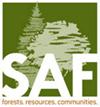Prefire Drought Intensity Drives Postfire Recovery and Mortality in Pinus monticola and Pseudotsuga menziesii Saplings
IF 1.5
4区 农林科学
Q2 FORESTRY
引用次数: 0
Abstract
Increasing frequency of droughts and wildfire are sparking concerns that these compounded disturbance events are pushing forested ecosystems beyond recovery. An improved understanding of how compounded events affect tree physiology and mortality is needed given the reliance of fire management planning on accurate estimates of postfire tree mortality. In this study, we use a toxicological dose-response approach to quantify the impact of variable-intensity drought and fire on the physiology and mortality of Pinus monticola and Pseudotsuga menziesii saplings. We show that the dose-response relationship between fire intensity and mortality shifts toward increased vulnerability under drought, indicating higher mortality with increasing drought at any fire intensity. The trajectory we observed in postfire chlorophyll fluorescence, an indicator of photosynthetic efficiency and stress, was an effective early warning sign of impending tree death. Postfire mortality modeling shows that accurate mortality classification can be achieved using prefire physiology and morphology metrics combined with fire intensity. Variable importance measures indicate that physiological condition and fire intensity have greater influence on the classification accuracy than morphological metrics. The wide range in drought and fire responses observed between this study and others highlights the need for more research on compound disturbance effects. Study Implications: An improved understanding of how drought and fire affect tree physiology and mortality is needed by natural resource managers looking to predict postfire tree mortality. This study advances our compound disturbance understanding by subjecting conifer saplings to variable drought and fire intensities and quantifying and modeling moderate-term recovery and mortality. The results show reduced physiological recovery and amplified mortality in saplings exposed to greater drought and fire intensity. Overall, this study highlights the importance of physiological condition when modeling tree mortality and could potentially be used to inform current postfire tree mortality models.火灾前的干旱强度决定了红松和红叶石楠树苗火灾后的恢复和死亡率
日益频繁的干旱和野火引发了人们的担忧,即这些复合干扰事件正在使森林生态系统无法恢复。鉴于火灾管理规划依赖于对火灾后树木死亡率的准确估计,因此需要更好地了解复合事件如何影响树木的生理机能和死亡率。在这项研究中,我们采用毒理学剂量-反应方法来量化不同强度的干旱和火灾对单叶松和红松树苗的生理机能和死亡率的影响。我们的研究表明,火灾强度与死亡率之间的剂量-反应关系趋向于在干旱条件下的脆弱性增加,这表明在任何火灾强度下,死亡率都会随着干旱程度的增加而增加。我们观察到的火灾后叶绿素荧光(光合作用效率和压力指标)的变化轨迹是树木即将死亡的有效预警信号。火灾后的死亡率建模表明,火灾前的生理和形态指标与火灾强度相结合,可以实现准确的死亡率分类。变量重要性测量结果表明,生理状况和火灾强度对分类准确性的影响大于形态指标。本研究和其他研究中观察到的干旱和火灾反应差异很大,这凸显了对复合干扰效应进行更多研究的必要性。研究意义:希望预测火灾后树木死亡率的自然资源管理者需要进一步了解干旱和火灾如何影响树木的生理机能和死亡率。本研究通过将针叶树苗置于不同的干旱和火灾强度下,并对中期恢复和死亡率进行量化和建模,加深了我们对复合干扰的理解。研究结果表明,在更大的干旱和火灾强度下,树苗的生理恢复能力降低,死亡率增加。总之,这项研究强调了在建立树木死亡率模型时生理状况的重要性,并有可能为目前的火灾后树木死亡率模型提供参考。
本文章由计算机程序翻译,如有差异,请以英文原文为准。
求助全文
约1分钟内获得全文
求助全文
来源期刊

Forest Science
农林科学-林学
CiteScore
2.80
自引率
7.10%
发文量
45
审稿时长
3 months
期刊介绍:
Forest Science is a peer-reviewed journal publishing fundamental and applied research that explores all aspects of natural and social sciences as they apply to the function and management of the forested ecosystems of the world. Topics include silviculture, forest management, biometrics, economics, entomology & pathology, fire & fuels management, forest ecology, genetics & tree improvement, geospatial technologies, harvesting & utilization, landscape ecology, operations research, forest policy, physiology, recreation, social sciences, soils & hydrology, and wildlife management.
Forest Science is published bimonthly in February, April, June, August, October, and December.
 求助内容:
求助内容: 应助结果提醒方式:
应助结果提醒方式:


